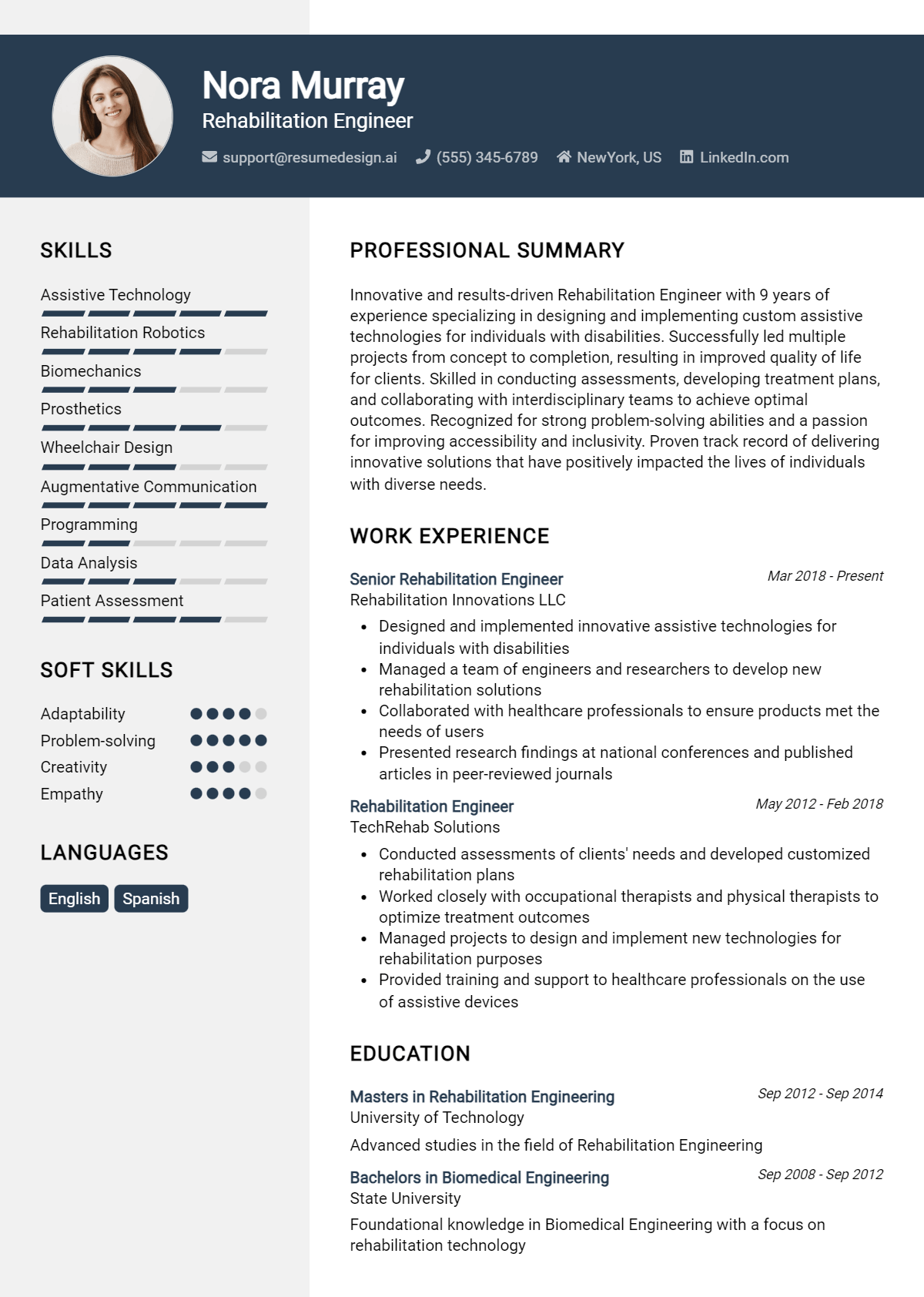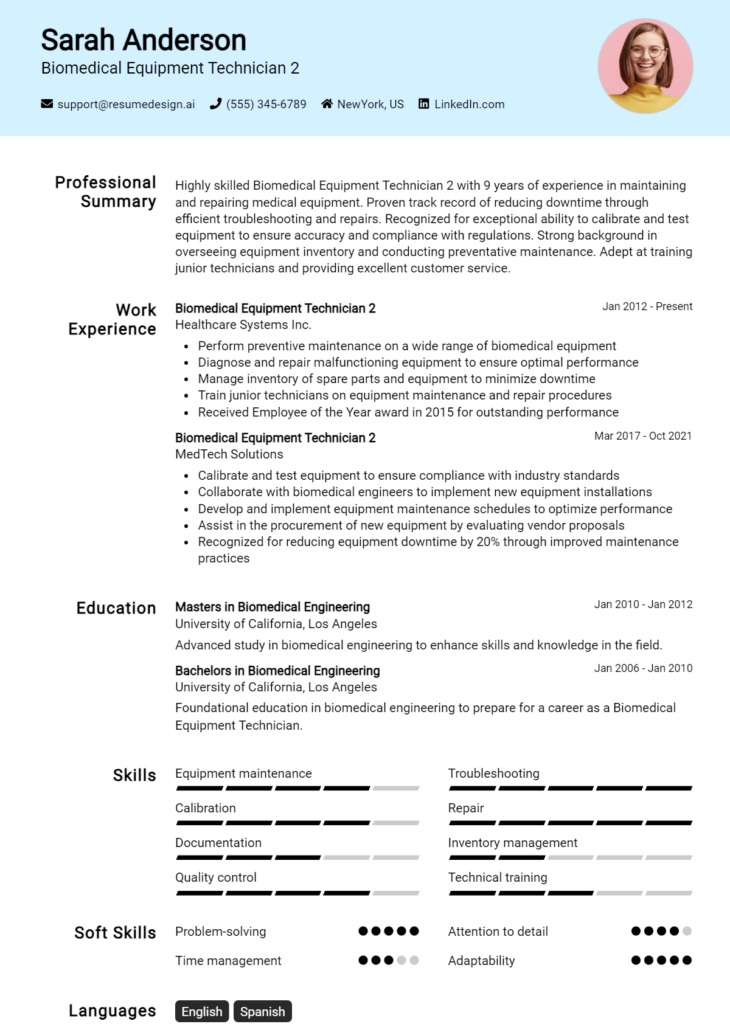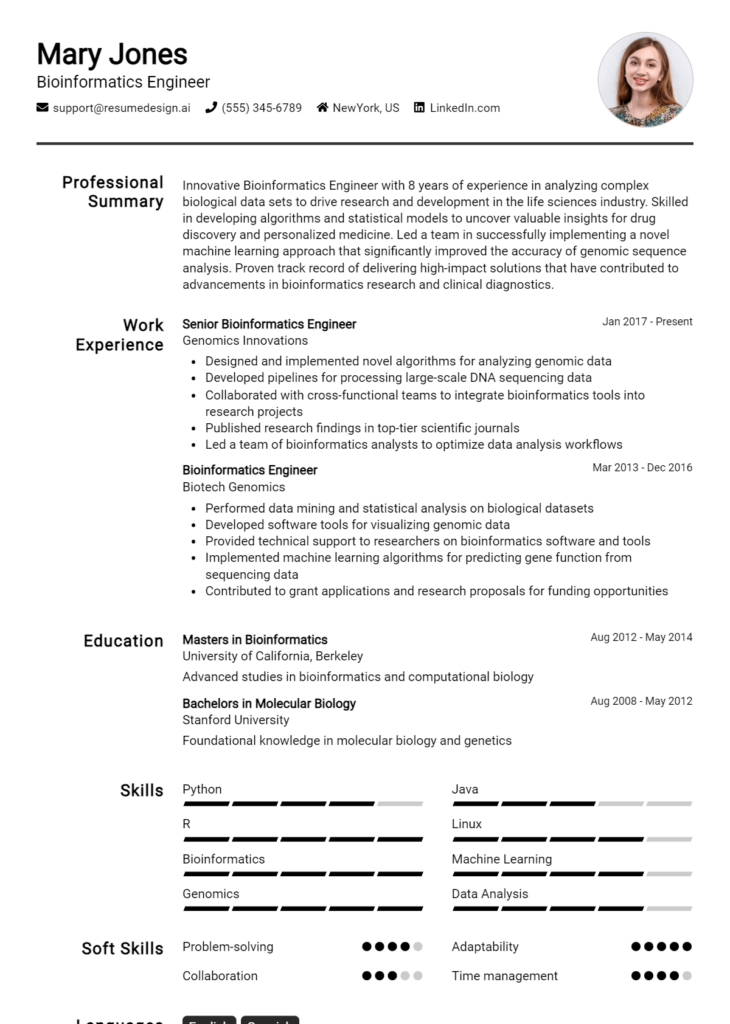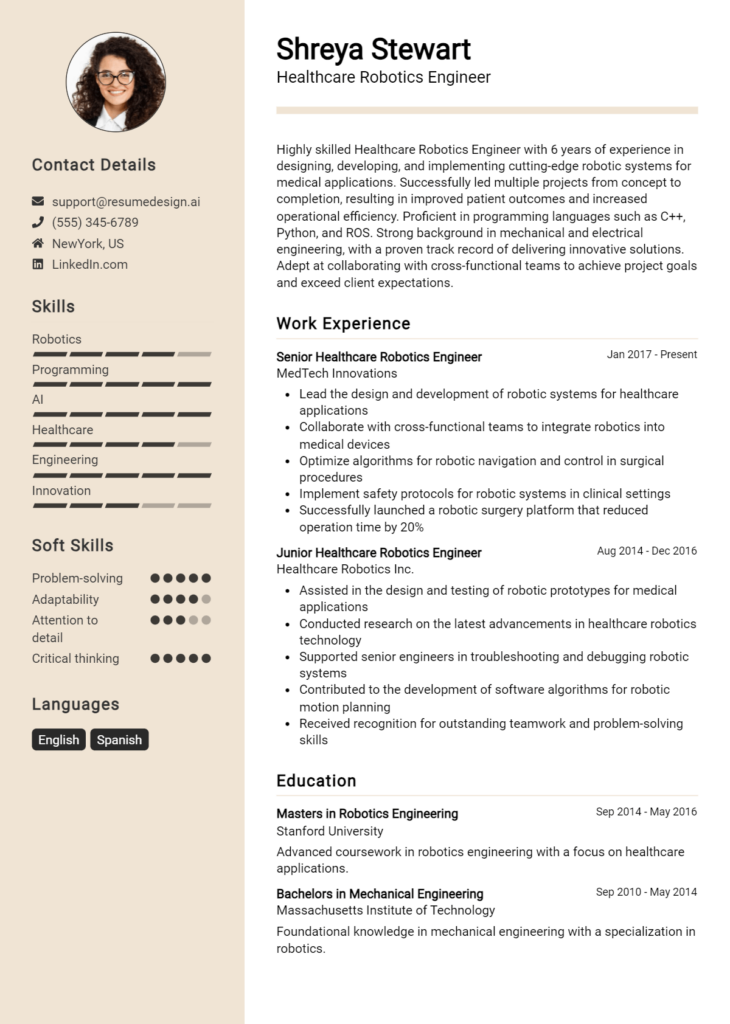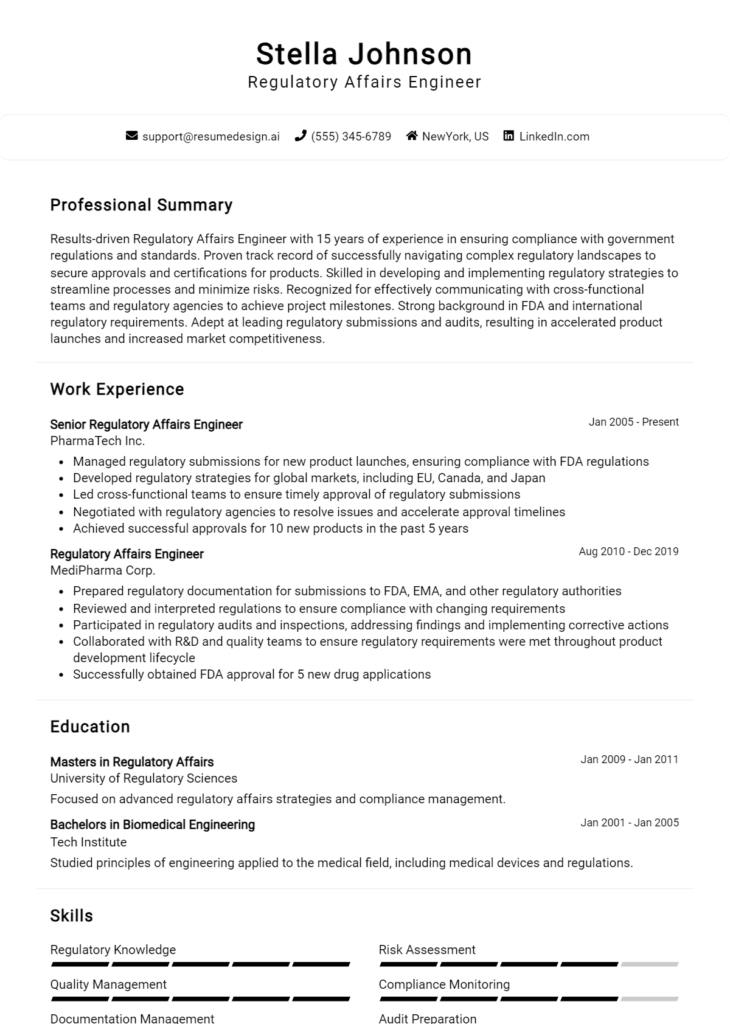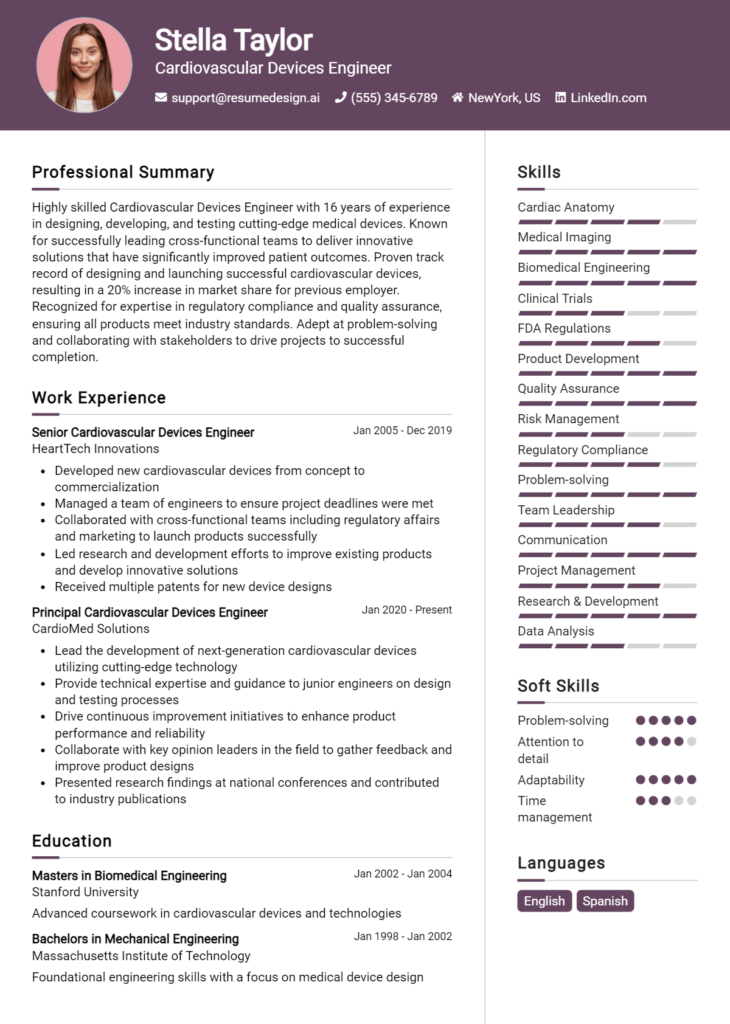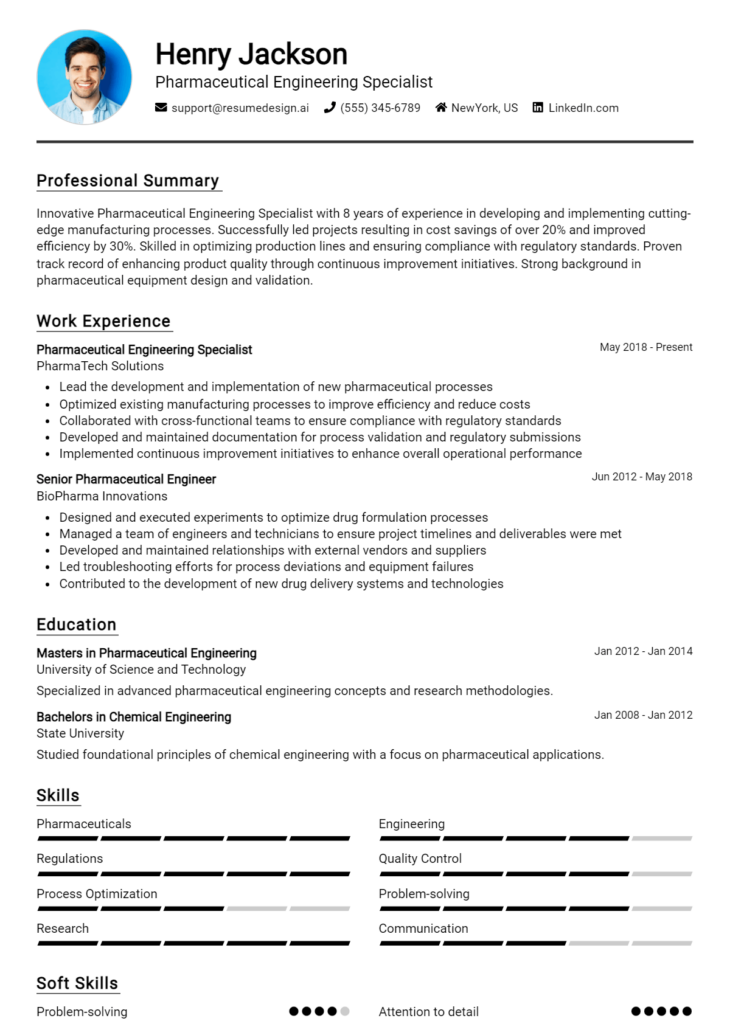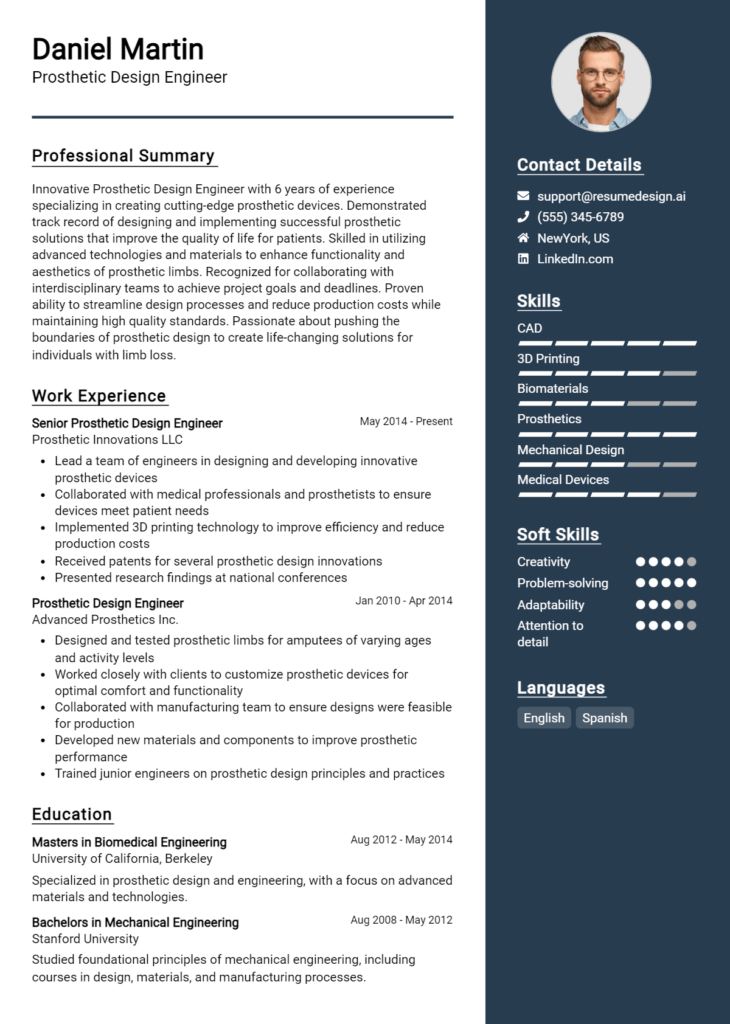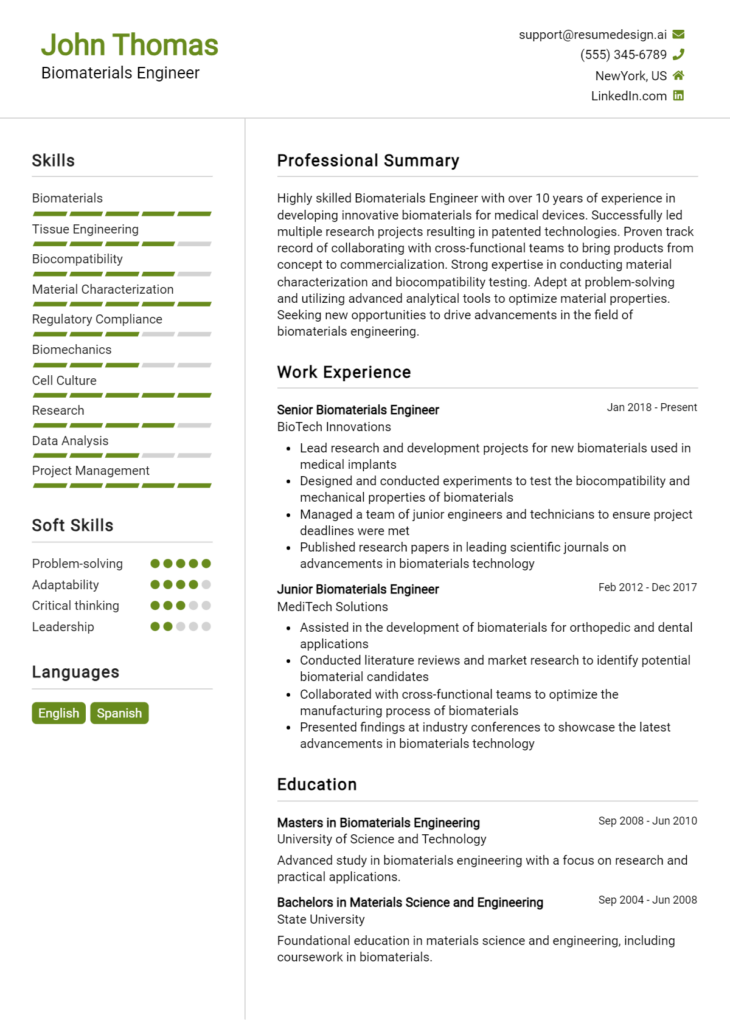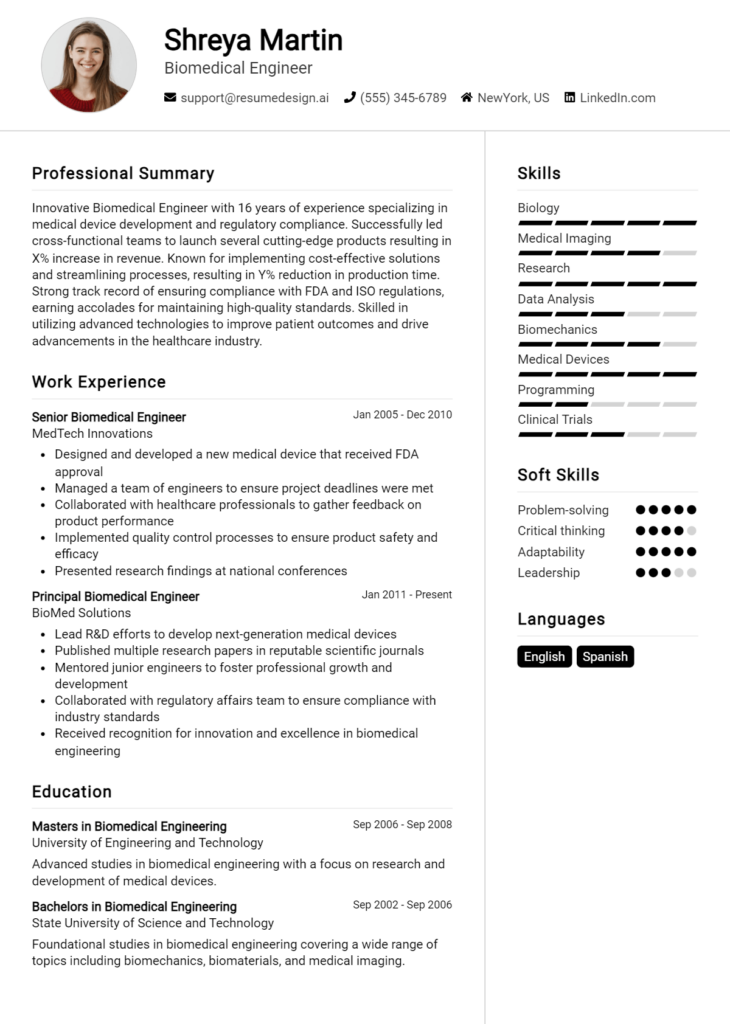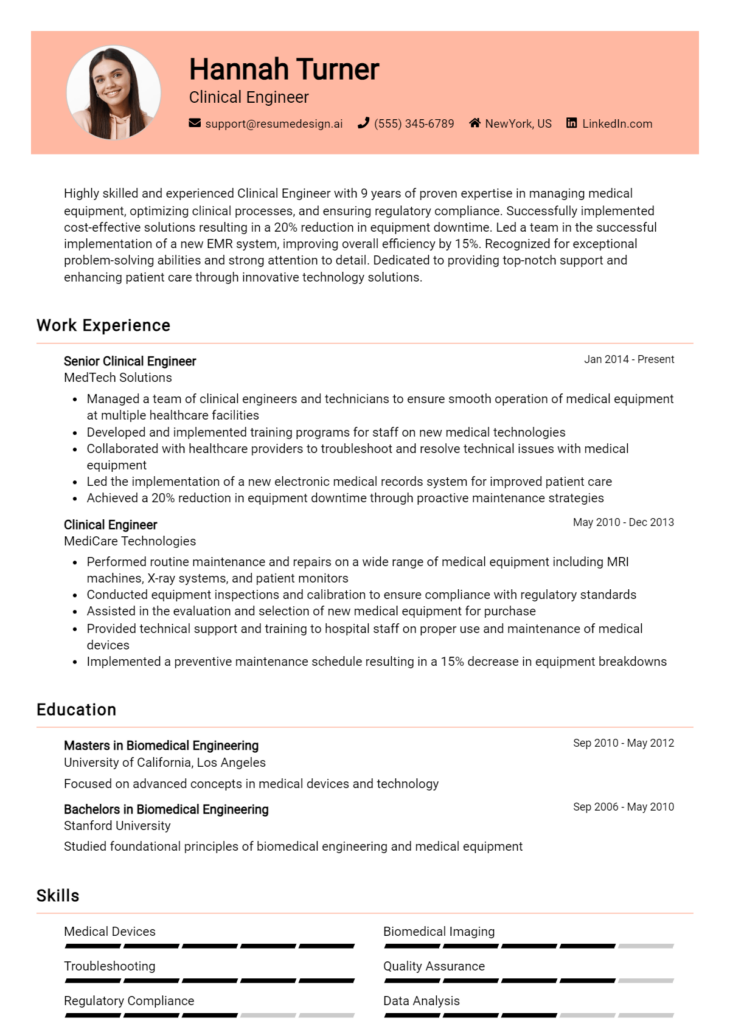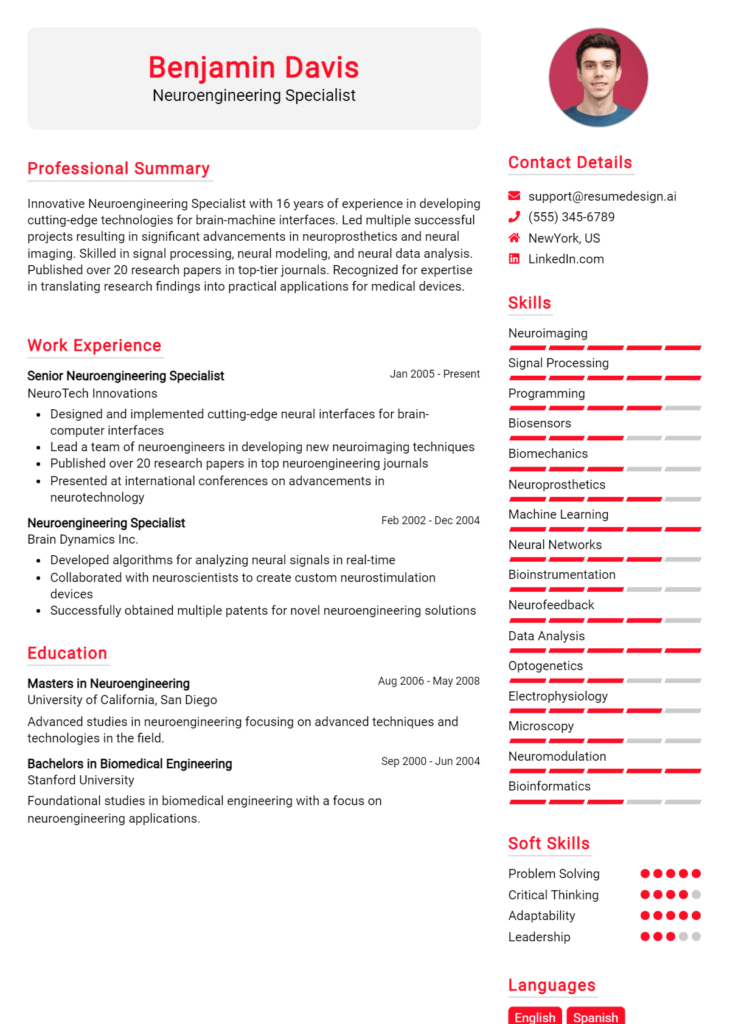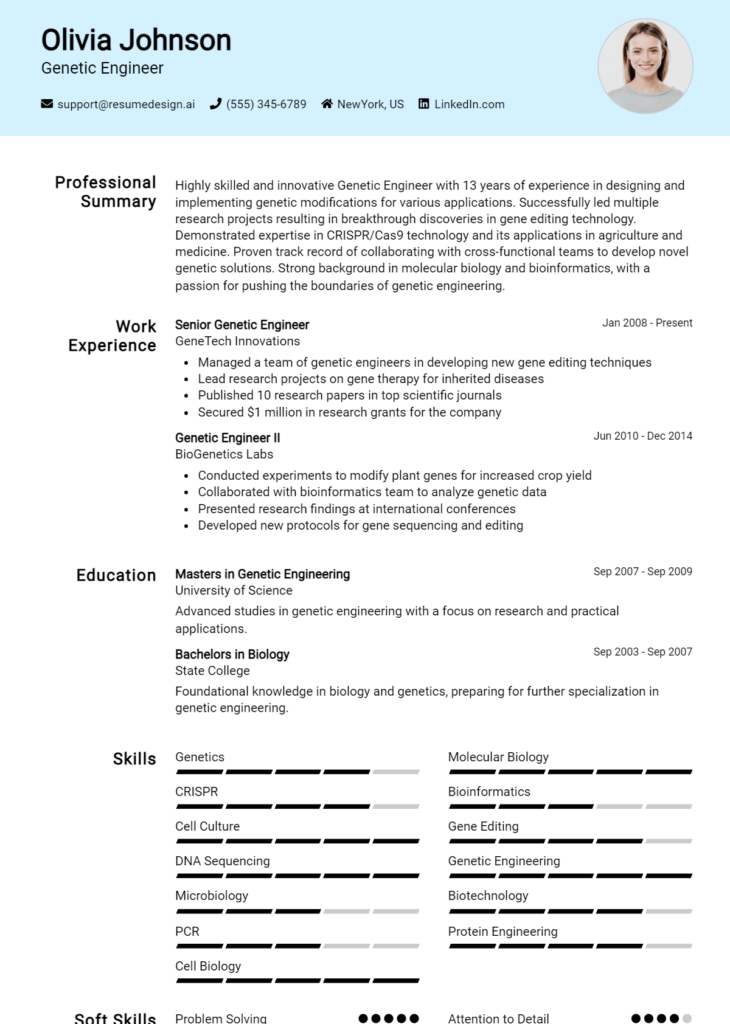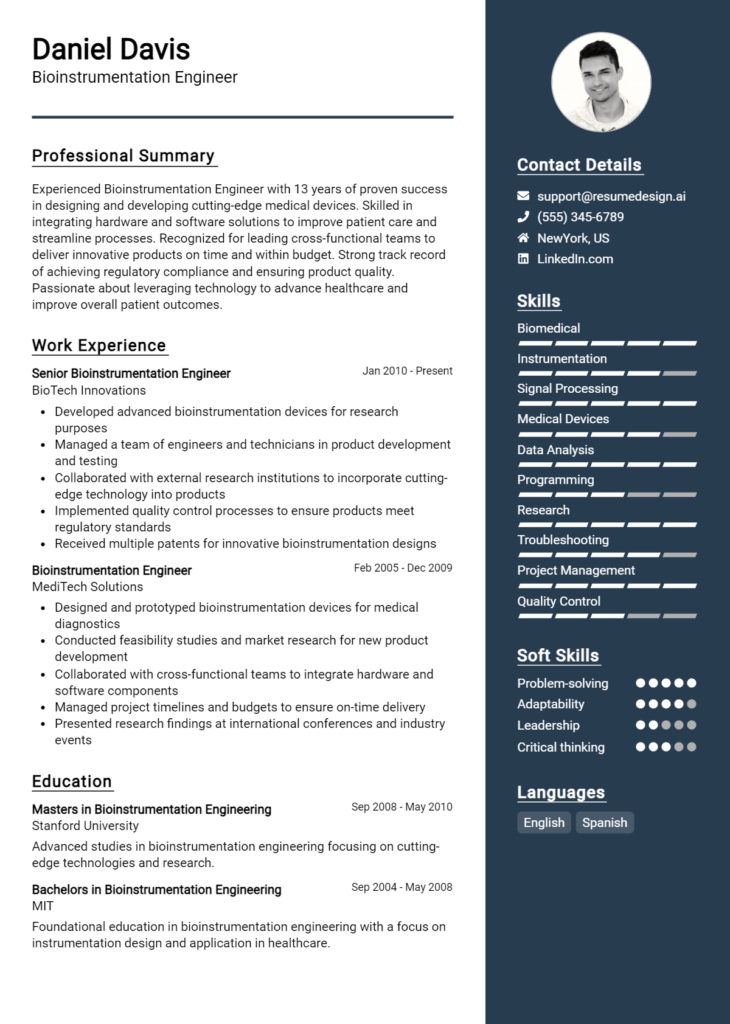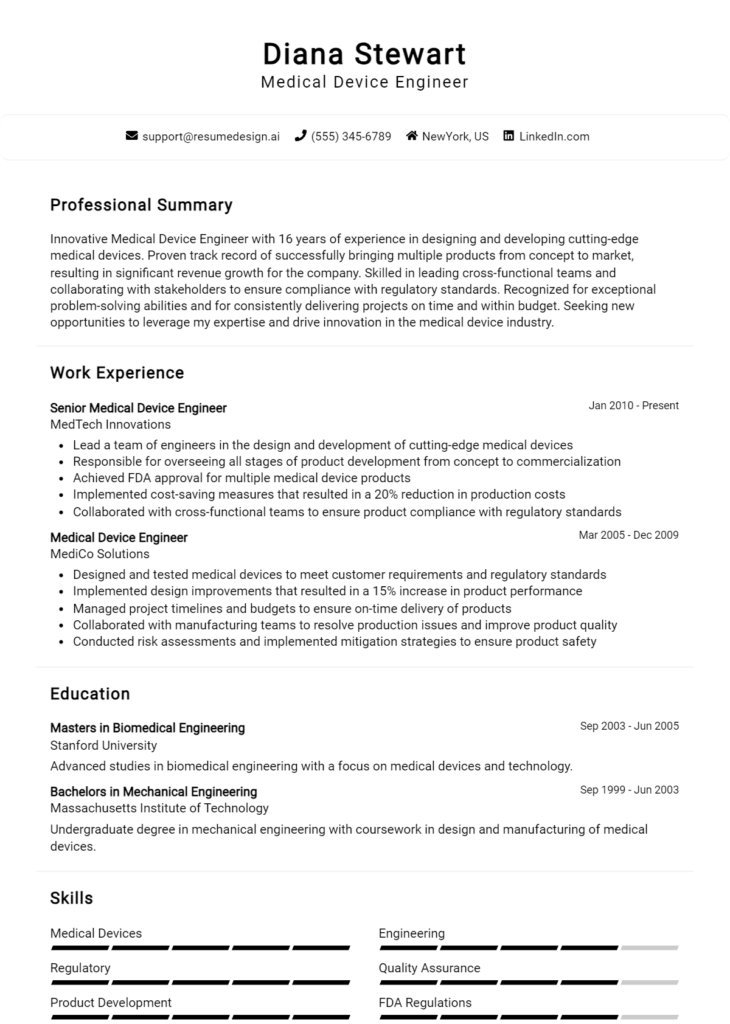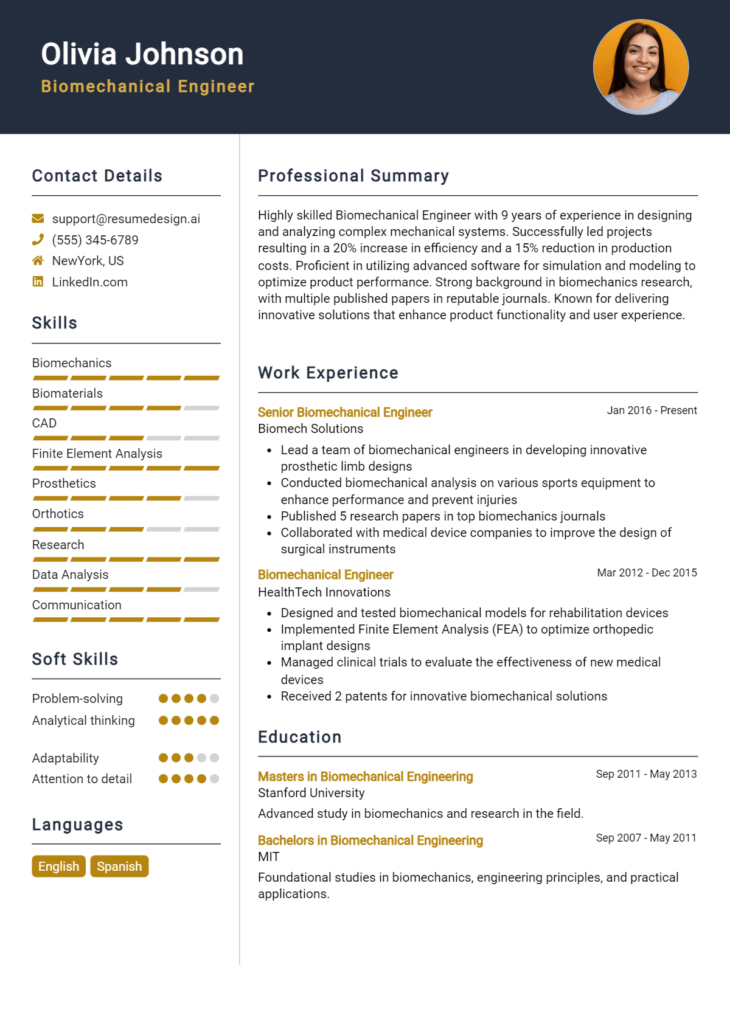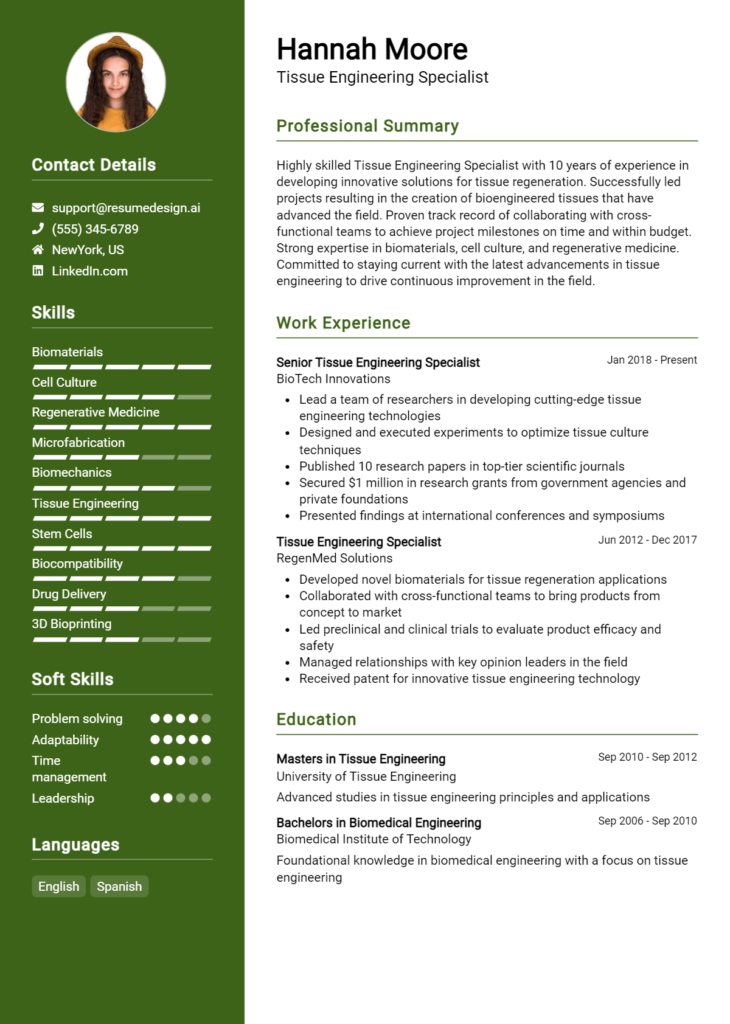Rehabilitation Engineer Core Responsibilities
A Rehabilitation Engineer plays a crucial role in designing and implementing assistive technologies that enhance the quality of life for individuals with disabilities. Key responsibilities include assessing patients’ needs, collaborating with healthcare professionals, and developing customized rehabilitation solutions. Technical expertise, operational savvy, and strong problem-solving skills are essential for success in this role, as they facilitate seamless communication across departments. A well-structured resume effectively highlights these qualifications and demonstrates the engineer's contribution to the organization's overarching goals.
Common Responsibilities Listed on Rehabilitation Engineer Resume
- Assessing patients' functional capabilities and rehabilitation needs.
- Designing and developing assistive devices and technologies.
- Collaborating with healthcare teams to create integrated care plans.
- Conducting research to improve rehabilitation techniques and equipment.
- Providing training and support for patients and caregivers.
- Ensuring compliance with regulatory standards and guidelines.
- Evaluating the effectiveness of rehabilitation solutions.
- Managing project timelines and budgets for rehabilitation initiatives.
- Documenting patient progress and equipment performance.
- Participating in interdisciplinary meetings and workshops.
- Staying updated on advancements in rehabilitation technology.
- Advocating for accessibility and inclusion in community settings.
High-Level Resume Tips for Rehabilitation Engineer Professionals
In the competitive field of Rehabilitation Engineering, a well-crafted resume is not just a document; it is often the first impression a candidate makes on potential employers. This critical tool must effectively showcase your unique blend of skills, accomplishments, and industry knowledge. A strong resume can open doors, leading to interviews and ultimately, job offers. In this guide, we will provide practical and actionable resume tips specifically tailored for Rehabilitation Engineer professionals, ensuring that your resume stands out in a crowded job market.
Top Resume Tips for Rehabilitation Engineer Professionals
- Tailor your resume to each job description by incorporating keywords and phrases from the listing.
- Highlight relevant experience by focusing on positions that directly relate to rehabilitation engineering.
- Quantify your achievements wherever possible, using metrics to demonstrate your impact (e.g., improved patient mobility by 30%).
- Showcase industry-specific skills, such as knowledge of assistive technologies, biomechanics, or adaptive device design.
- Include certifications and licenses that are relevant to the field, such as a Professional Engineer (PE) license.
- Utilize a clean, professional format with clear headings and bullet points for easy readability.
- Incorporate a summary statement that highlights your professional background and career goals in rehabilitation engineering.
- List any relevant publications or research projects that demonstrate your expertise and commitment to the field.
- Include volunteer work or internships in healthcare settings that display your dedication to improving patient outcomes.
- Proofread meticulously to eliminate errors and ensure clarity, as attention to detail is crucial in engineering roles.
By implementing these tips, you can significantly increase your chances of landing a job in the Rehabilitation Engineer field. A polished and targeted resume not only showcases your qualifications but also demonstrates your commitment to excellence and your understanding of the industry's demands, setting you apart from other candidates.
Why Resume Headlines & Titles are Important for Rehabilitation Engineer
In the competitive field of rehabilitation engineering, a well-crafted resume headline or title plays a crucial role in capturing the attention of hiring managers. This concise phrase serves as a snapshot of a candidate's qualifications, summarizing their expertise and unique selling points in a way that is both engaging and informative. A strong headline not only highlights the applicant’s relevant skills and experiences but also sets the tone for the rest of the resume. It should be relevant, targeted, and immediately convey the value that the candidate brings to the table, making it essential for standing out in a crowded job market.
Best Practices for Crafting Resume Headlines for Rehabilitation Engineer
- Keep it concise – Aim for a headline that is no longer than one or two lines.
- Make it role-specific – Tailor the headline to reflect the specific position you are applying for.
- Use impactful language – Choose strong verbs and adjectives that convey your skills and accomplishments.
- Highlight key qualifications – Focus on your most relevant skills or experiences that align with the job description.
- Avoid jargon or buzzwords – Be clear and straightforward, avoiding overly technical terms that may confuse hiring managers.
- Include measurable achievements – If possible, quantify your successes to provide a clearer picture of your capabilities.
- Reflect your career level – Use language that accurately represents your level of experience, whether entry-level, mid-career, or senior.
- Revise for clarity – Review and refine your headline to ensure it communicates your value effectively.
Example Resume Headlines for Rehabilitation Engineer
Strong Resume Headlines
Innovative Rehabilitation Engineer with 5+ Years in Assistive Technology Development
Certified Rehabilitation Engineer Specializing in Custom Prosthetic Solutions
Results-Driven Rehabilitation Engineer with Proven Record in Patient-Centric Design
Weak Resume Headlines
Engineer Looking for Opportunities
Rehabilitation Engineer Seeking Job
The strong headlines are effective because they provide specific information about the candidate’s expertise and achievements, making them immediately relevant to potential employers. They convey confidence and clarity, allowing hiring managers to quickly assess the applicant's fit for the role. In contrast, the weak headlines lack detail and specificity, making them bland and forgettable. Vague phrases fail to communicate the candidate's unique qualifications or the value they can bring to the organization, resulting in a missed opportunity to stand out in a competitive job market.
Writing an Exceptional Rehabilitation Engineer Resume Summary
A resume summary is a critical component for a Rehabilitation Engineer, as it serves as the first impression a candidate makes on hiring managers. An effective summary succinctly encapsulates key skills, relevant experience, and notable accomplishments, immediately capturing the attention of potential employers. This brief overview should be concise yet impactful, tailored specifically to the job in question, and designed to highlight the candidate's unique qualifications that align with the requirements of the position. A well-crafted resume summary can set the tone for the entire application, making the difference between landing an interview and being overlooked.
Best Practices for Writing a Rehabilitation Engineer Resume Summary
- Quantify achievements: Use numbers and metrics to demonstrate your impact and contributions.
- Focus on relevant skills: Highlight the technical and soft skills that are directly applicable to the role.
- Tailor to the job description: Customize your summary to reflect the specific requirements and language used in the job posting.
- Keep it concise: Aim for 2-4 sentences that deliver maximum information without being overly verbose.
- Showcase key accomplishments: Mention significant projects or experiences that illustrate your expertise.
- Use strong action verbs: Start sentences with dynamic verbs to convey a sense of proactivity and professionalism.
- Maintain clarity: Avoid jargon and overly complex language to ensure your summary is easily understood.
- Reflect your passion: Convey enthusiasm for the field and commitment to improving the lives of individuals through rehabilitation engineering.
Example Rehabilitation Engineer Resume Summaries
Strong Resume Summaries
Dedicated Rehabilitation Engineer with over 8 years of experience designing adaptive devices that improved mobility for over 500 patients, resulting in a 30% increase in patient satisfaction ratings. Proficient in CAD software and assistive technology, and committed to enhancing quality of life through innovative solutions.
Results-driven Rehabilitation Engineer with a proven track record of developing and implementing assistive technologies that reduced rehabilitation time by 25%. Skilled in biomechanical analysis and user-centered design, with a strong focus on patient-centered outcomes.
Innovative Rehabilitation Engineer with 5+ years of experience in creating custom prosthetic solutions, achieving a 40% improvement in functionality as reported by users. Adept in multidisciplinary collaboration, driving projects from concept to execution with a focus on enhancing user experience.
Weak Resume Summaries
Rehabilitation Engineer seeking a position where I can utilize my skills. I have experience and knowledge in the field.
Motivated engineer looking for a job in rehabilitation engineering. I am interested in helping people and have worked with technology.
The strong resume summaries are effective because they provide specific examples of achievements, quantify the impact of the candidate's work, and directly relate to the responsibilities of a Rehabilitation Engineer. In contrast, the weak summaries lack detail, specificity, and quantifiable results, making them less memorable and impactful. They fail to convey the candidate's true capabilities and relevance to the role, which may lead to missed opportunities in the hiring process.
Work Experience Section for Rehabilitation Engineer Resume
The work experience section of a Rehabilitation Engineer resume is crucial as it serves as a testament to the candidate's technical skills and their capacity to manage teams effectively while delivering high-quality products. This section allows applicants to showcase their hands-on experience in designing and implementing assistive technologies, rehabilitation devices, and other innovative solutions that improve the quality of life for individuals with disabilities. By quantifying achievements and aligning their experience with industry standards, candidates can demonstrate their impact and value to potential employers, making a compelling case for their candidacy.
Best Practices for Rehabilitation Engineer Work Experience
- Highlight relevant technical skills and certifications that pertain to rehabilitation engineering.
- Quantify achievements with specific metrics, such as percentage improvements, cost savings, or successful project outcomes.
- Showcase collaborative projects that demonstrate teamwork and the ability to work across various disciplines.
- Include leadership roles that illustrate the ability to manage teams and projects effectively.
- Use action verbs to create dynamic descriptions of responsibilities and accomplishments.
- Align experience with recognized industry standards and practices to emphasize relevance.
- Provide context for each role, detailing the challenges faced and the solutions implemented.
- Tailor the work experience section to match the specific job requirements of the position being applied for.
Example Work Experiences for Rehabilitation Engineer
Strong Experiences
- Led a multidisciplinary team to develop an advanced prosthetic limb that increased user mobility by 30%, resulting in a 25% improvement in patient satisfaction scores.
- Designed and implemented a rehabilitation software system that streamlined patient tracking and improved treatment plan adherence by 40% across 200+ patients.
- Managed the successful launch of a new assistive technology device that reduced production costs by 15% while enhancing functionality, reaching over 500 users within the first year.
Weak Experiences
- Worked on various projects related to rehabilitation engineering without specific details on contributions or outcomes.
- Participated in team meetings and discussions about engineering solutions.
- Assisted senior engineers with tasks and responsibilities in a general capacity.
The examples labeled as strong experiences stand out due to their specificity and quantifiable outcomes, illustrating clear contributions to projects and demonstrating leadership and collaboration. In contrast, the weak experiences lack detail and measurable achievements, making it difficult for potential employers to gauge the candidate's impact or technical expertise. Strong statements articulate not just what was done, but the significance of those actions in terms of results and benefits to the organization or clients served.
Education and Certifications Section for Rehabilitation Engineer Resume
The education and certifications section of a Rehabilitation Engineer resume plays a crucial role in establishing the candidate's qualifications and expertise in the field. This section not only highlights the academic background and relevant degrees but also showcases industry-recognized certifications and continuous learning efforts that are essential in a constantly evolving discipline. By detailing relevant coursework, specialized training, and certifications, candidates can significantly enhance their credibility, demonstrating their alignment with the job role and their commitment to staying current in rehabilitation engineering practices.
Best Practices for Rehabilitation Engineer Education and Certifications
- Include degrees from accredited institutions, specifically in fields related to engineering, rehabilitation, or biomechanics.
- List industry-recognized certifications, such as Certified Rehabilitation Engineer (CRE) or Assistive Technology Professional (ATP).
- Highlight relevant coursework that directly pertains to rehabilitation engineering, such as biomechanics, clinical rehabilitation, and assistive technology.
- Keep the section organized, using clear headings for degrees, certifications, and any additional training.
- Update the section regularly to reflect new certifications or continuing education courses that enhance your expertise.
- Prioritize recent and relevant educational experiences over older qualifications that may no longer be applicable.
- Incorporate any specialized training or workshops that relate to the latest technologies in rehabilitation engineering.
- Avoid including irrelevant degrees or certifications that do not contribute to your qualifications in rehabilitation engineering.
Example Education and Certifications for Rehabilitation Engineer
Strong Examples
- M.S. in Rehabilitation Engineering, University of XYZ, 2021
- Certified Rehabilitation Engineer (CRE), Rehabilitation Engineering and Assistive Technology Society of North America, 2022
- Coursework in Biomechanics and Prosthetics Design, University of XYZ
- Assistive Technology Professional (ATP), Rehabilitation Engineering Society, 2023
Weak Examples
- B.A. in History, University of ABC, 2015
- Certification in Basic First Aid, American Red Cross, 2018
- Online Course in Microsoft Excel, Coursera, 2020
- High School Diploma, XYZ High School, 2010
The examples provided highlight the importance of relevance and specificity in the education and certifications section. The strong examples demonstrate a clear alignment with the Rehabilitation Engineer role, showcasing advanced degrees, specialized certifications, and pertinent coursework that enhance the candidate's qualifications. In contrast, the weak examples reflect outdated or unrelated qualifications that do not contribute to the candidate's competency in rehabilitation engineering, underscoring the need to focus on relevant education and credentials that resonate with the desired job role.
Top Skills & Keywords for Rehabilitation Engineer Resume
As a Rehabilitation Engineer, possessing a mix of both hard and soft skills is crucial for creating and implementing effective solutions that enhance the quality of life for individuals with disabilities. A well-crafted resume should highlight these skills, showcasing not only technical expertise but also interpersonal abilities that make an engineer more effective in collaborative environments. Skills are the foundation of your qualifications and are key to demonstrating your capabilities to potential employers. They help in establishing your proficiency in the field and can set you apart from other candidates. For more information on how to effectively incorporate skills into your resume, check out this guide on skills.
Top Hard & Soft Skills for Rehabilitation Engineer
Soft Skills
- Empathy
- Communication
- Problem-solving
- Teamwork
- Adaptability
- Patience
- Attention to detail
- Creativity
- Time management
- Ethical judgment
Hard Skills
- Assistive technology design
- CAD software proficiency
- Knowledge of biomechanics
- Prototyping and testing
- Regulatory compliance (e.g., FDA regulations)
- Materials science
- Data analysis
- Project management
- Rehabilitation protocols
- Electrical engineering principles
For insights on how to effectively showcase your professional background, including work experience, you can explore additional resources that can help you build a compelling resume.
Stand Out with a Winning Rehabilitation Engineer Cover Letter
I am writing to express my interest in the Rehabilitation Engineer position at [Company Name], as advertised on [Job Board/Company Website]. With a strong background in biomedical engineering and a passion for enhancing the quality of life for individuals with disabilities, I am excited about the opportunity to contribute my skills and expertise to your esteemed organization. My academic training, combined with hands-on experience in assistive technology and patient-centered design, positions me to make a meaningful impact in this role.
Throughout my career, I have successfully collaborated with multidisciplinary teams to develop innovative solutions that address the unique needs of patients. For example, during my internship at [Previous Company/Institution], I designed a custom wheelchair modification that improved mobility and comfort for a patient with severe spinal injuries. This experience deepened my understanding of the importance of incorporating user feedback into the design process and reinforced my commitment to creating adaptive devices that empower users. I am proficient in CAD software and have experience with 3D printing technology, allowing me to prototype and test designs efficiently.
In addition to my technical skills, I possess strong communication and interpersonal abilities, which I believe are crucial for a Rehabilitation Engineer. I have had the privilege of working directly with patients and healthcare professionals, facilitating discussions to ensure that the solutions we develop are not only functional but also user-friendly. I am also committed to staying abreast of industry advancements and best practices, attending conferences and workshops to continually improve my knowledge and skills.
I am excited about the possibility of joining [Company Name] and contributing to your mission of providing cutting-edge rehabilitation solutions. I am eager to bring my unique blend of engineering expertise and compassionate patient care to your team. Thank you for considering my application; I look forward to the opportunity to discuss how my background and enthusiasm align with the goals of your organization.
Common Mistakes to Avoid in a Rehabilitation Engineer Resume
When crafting a resume for the role of a Rehabilitation Engineer, it's crucial to present your qualifications and experiences effectively. However, many candidates fall into common pitfalls that can hinder their chances of landing an interview. Understanding these mistakes can help you create a more compelling resume that highlights your skills and expertise in the rehabilitation engineering field.
Neglecting Relevant Skills: Failing to include specific skills related to rehabilitation engineering, such as knowledge of assistive technology or experience with biomechanical assessments, can make your resume less impactful.
Using Generic Job Descriptions: Copying and pasting job descriptions from previous roles without tailoring them to your specific experiences can come off as disingenuous and may not effectively showcase your contributions.
Omitting Soft Skills: Rehabilitation engineering often requires strong interpersonal skills. Neglecting to highlight qualities like empathy, communication, and teamwork can diminish your appeal as a candidate.
Inconsistent Formatting: A resume that lacks a uniform format can be distracting. Use consistent font styles, sizes, and spacing to ensure your resume is easy to read and visually appealing.
Lack of Quantifiable Achievements: Simply listing responsibilities without quantifying accomplishments makes it difficult for employers to gauge your impact. Use metrics to demonstrate how your work contributed to team or project successes.
Ignoring Keywords: Many companies use applicant tracking systems (ATS) to screen resumes. Failing to incorporate relevant industry keywords can result in your resume being overlooked in the initial screening process.
Too Much Technical Jargon: While technical knowledge is essential in this field, overloading your resume with jargon can alienate non-technical hiring managers. Strive for a balance that maintains professionalism while remaining accessible.
Not Including Continuing Education: The field of rehabilitation engineering is continually evolving. Omitting any certifications, workshops, or training you have completed can signal a lack of commitment to professional development.
Conclusion
As a Rehabilitation Engineer, your role is pivotal in enhancing the quality of life for individuals with disabilities through the design and development of assistive devices and technologies. Key responsibilities include assessing patient needs, collaborating with healthcare teams, and ensuring that the devices meet safety and effectiveness standards. Additionally, staying updated with the latest advancements in technology and rehabilitation practices is crucial to provide the best solutions for clients.
To stand out in this competitive field, it’s essential to have a well-crafted resume that highlights your relevant skills, experiences, and accomplishments. Take a moment to review your Rehabilitation Engineer resume to ensure it effectively communicates your qualifications and passion for helping others.
If you need assistance in crafting a standout resume, consider utilizing the various resources available to you. Explore resume templates that can help structure your information clearly. Use a resume builder to create a professional-looking document easily. Gain inspiration from resume examples tailored for rehabilitation engineering roles. And don't forget to enhance your application with a compelling cover letter by accessing cover letter templates.
Take action today and refine your resume to reflect your skills and aspirations in the field of rehabilitation engineering!

